Market Overview
The Global Holographic Display Market is predicted to be valued at USD 5.1 billion in 2025 and is expected to grow to USD 28.5 billion by 2034, registering a compound annual growth rate (CAGR) of 21.0% from 2025 to 2034.
A holographic display is an advanced visual technology that creates three-dimensional (3D) images using light diffraction. Unlike traditional 2D screens, it allows viewers to see objects from different angles without needing special glasses. This is achieved by recording and reconstructing light fields to project lifelike visuals in open space.
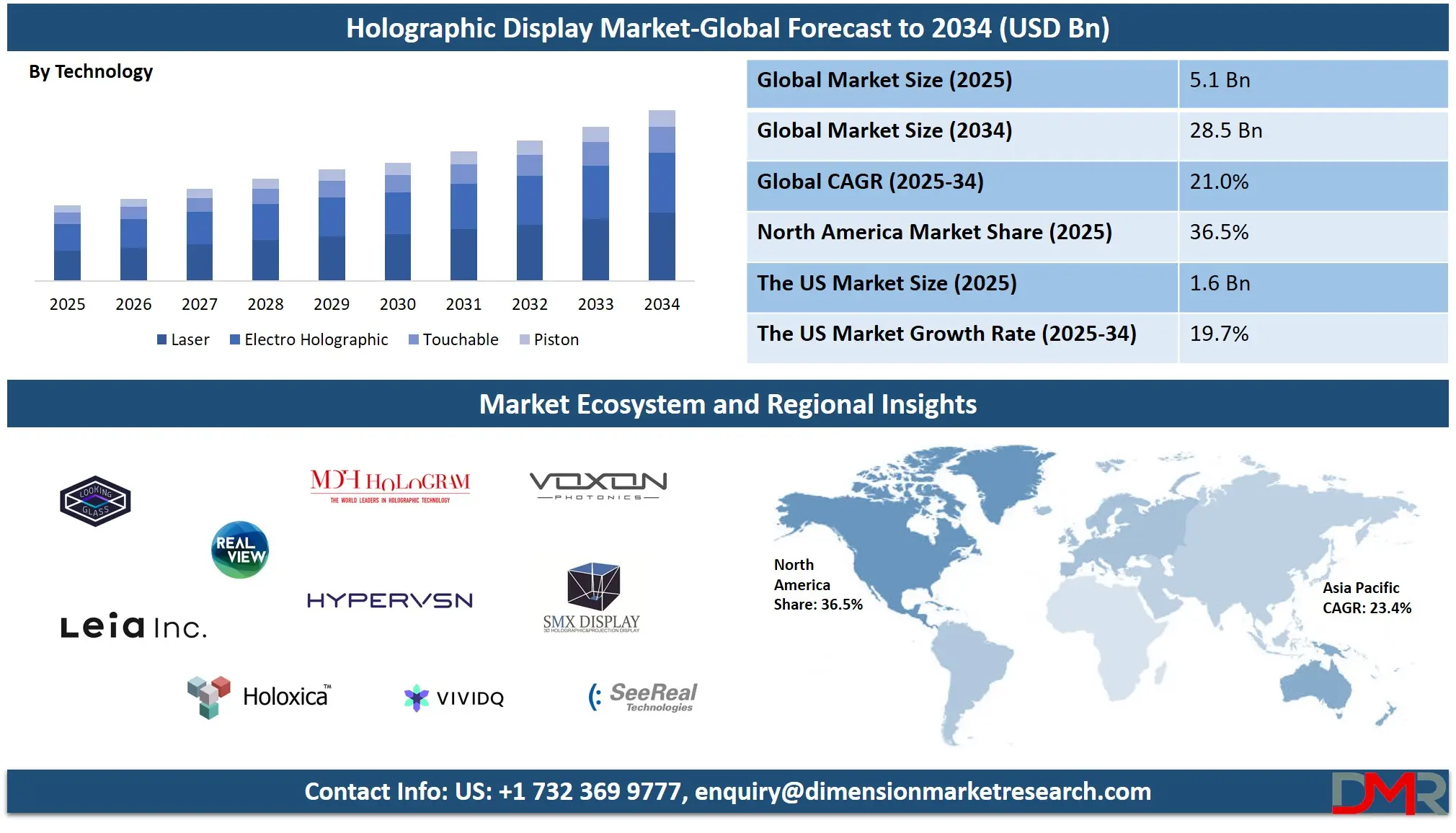
Holographic displays are used in areas such as Medical Imaging Display, advertising, education, automotive, and entertainment. They enhance user engagement by offering interactive, immersive experiences. The technology combines optics, lasers, and digital processing, and is rapidly evolving with innovations in augmented reality (AR), artificial intelligence (AI), and light field display systems.
The global holographic display market is experiencing transformative growth, driven by advancements in augmented reality, 3D imaging, and spatial light modulation technologies. A primary catalyst for this expansion is the increasing demand for immersive user experiences across sectors such as advertising, retail, automotive, healthcare, and entertainment. Holographic projection systems are gaining traction as they offer real-time, lifelike visuals without the need for wearable devices, setting them apart from traditional display solutions.
Emerging applications in medical imaging, where holography aids in detailed visualization of anatomical structures, and in automotive head-up displays that enhance driver awareness, are expanding the market scope. Furthermore, educational institutions and museums are increasingly adopting holographic screens and interactive display walls to deliver dynamic content and elevate viewer engagement.
The entertainment and gaming industries are capitalizing on volumetric displays and light field displays to enhance realism and user immersion. The rise of virtual meetings and events is also accelerating demand for holographic telepresence and digital avatars, which simulate in-person interactions. Holographic kiosks and touchless displays are being deployed in retail and hospitality environments to improve customer interaction and engagement.
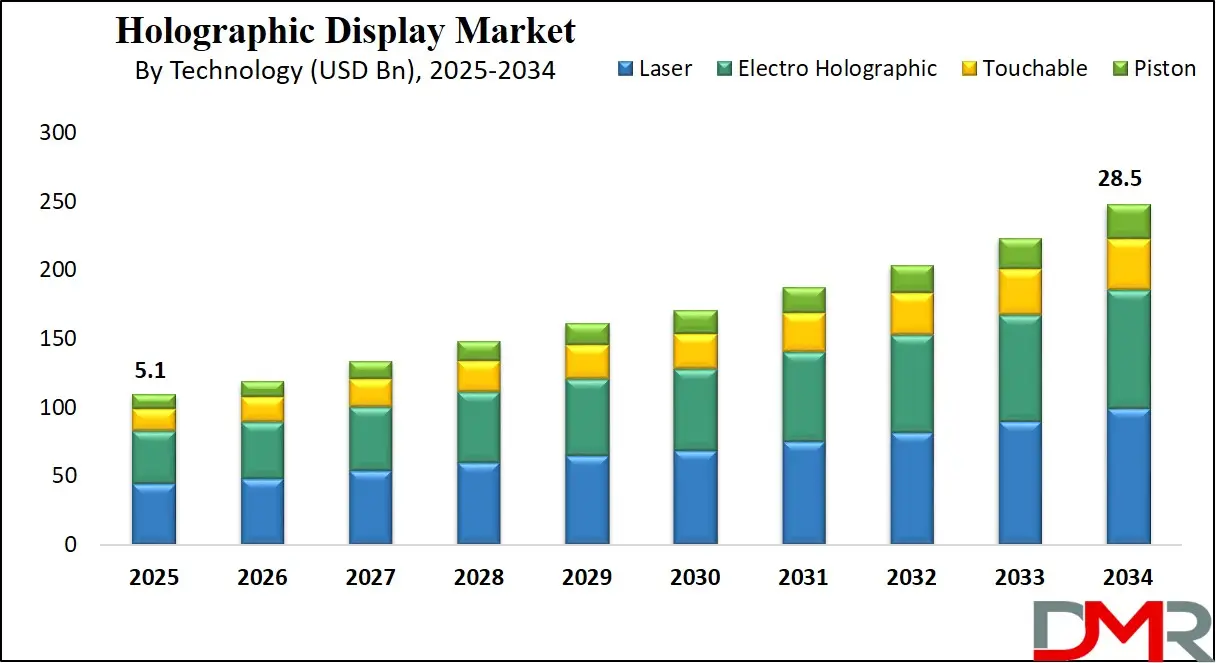
Media and tech giants are actively investing in Next-Generation Display technologies, with companies developing high-resolution holographic monitors and integrating AI and IoT capabilities for smarter, context-aware displays. Innovations in digital micromirror devices, spatial light modulators, and OLED Display systems are reshaping design possibilities.
Overall, the holographic display market is poised to redefine visual communication, with ongoing R&D and strategic collaborations creating lucrative opportunities across multiple verticals, including smart cities, defense, and personalized consumer electronics.
The US Holographic Display Market
The US Holographic Display Market is projected to be valued at USD 1.6 billion in 2025. It is expected to witness subsequent growth in the upcoming period as it holds USD 7.9 billion in 2034 at a CAGR of 19.7%.
The US holographic display market is driven by advancements in augmented reality (AR) and virtual reality (VR) technologies, along with increased integration of 3D visualization across industries such as healthcare, automotive, and retail. The strong presence of key tech giants investing in immersive display solutions fuels innovation.
Additionally, the growing demand for interactive holographic kiosks and digital signage in public venues supports market expansion. The defense and aerospace sectors are also increasingly adopting holographic interfaces for training and simulation purposes. A robust digital infrastructure and high consumer demand for futuristic entertainment experiences further enhance the adoption of holographic display technology.
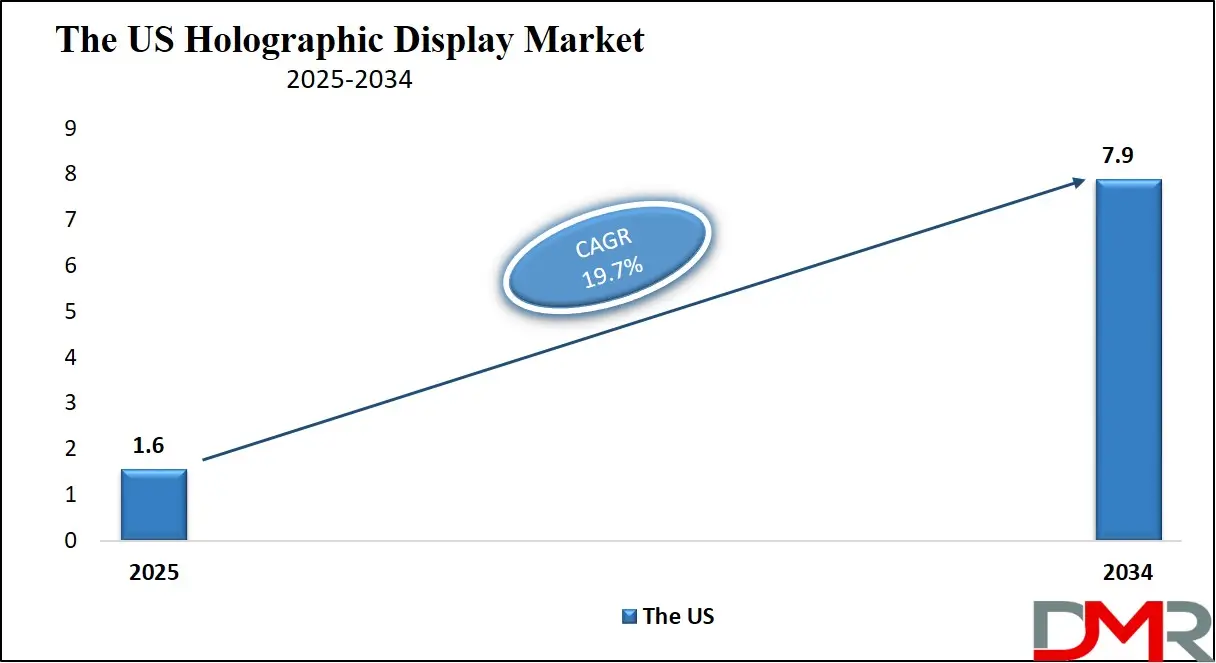
The US market is witnessing a shift toward volumetric and light-field displays, enhancing the realism of holographic content. Integration of artificial intelligence with holographic systems for gesture and voice recognition is gaining momentum. Companies are exploring holography in remote collaboration tools, creating more immersive conferencing environments.
There is a growing emphasis on touchless interfaces, especially in healthcare and retail, driven by hygiene-conscious behavior. Holographic advertising is becoming more prevalent in high-traffic urban areas. The convergence of 5G technology with holographic displays is also facilitating smoother and more interactive user experiences, particularly in gaming, live events, and remote education platforms.
The Japan Holographic Display Market
The Japan Holographic Display Market is projected to be valued at USD 0.8 billion in 2025. It is expected to witness subsequent growth in the upcoming period as it holds USD 4.2 billion in 2034 at a CAGR of 20.3%.
Japan’s holographic display market is primarily driven by its strong consumer electronics industry and a culture of early adoption of cutting-edge technologies. The integration of holographic displays into entertainment, gaming, and public experiences aligns well with the country’s demand for immersive content. The automotive sector is increasingly incorporating holographic HUDs for safer, distraction-free navigation.
In healthcare, Japanese hospitals and universities are exploring 3D holography for Medical Imaging Display and surgery planning. Supportive government initiatives encouraging digital innovation, along with partnerships between technology firms and universities, are accelerating research and commercialization of Next-Generation Display technologies in various application domains.
In Japan, holographic concerts and virtual idols are becoming mainstream, reflecting the country’s unique entertainment preferences. Retailers are adopting holographic assistants to offer personalized, contactless customer service.
The gaming industry is integrating 3D holographic interfaces for immersive gameplay experiences. Robotics and AI integration with holography is also gaining traction, particularly in humanoid robot interactions. Public infrastructure, including train stations and airports, is experimenting with holographic wayfinding and safety instructions. Academic and corporate research is pushing the boundaries of ultra-realistic and compact holographic projectors. Additionally, Japan’s increasing emphasis on smart cities is likely to support widespread deployment of holographic information systems.
The Europe Holographic Display Market
The Europe Holographic Display Market is projected to be valued at USD 1.4 billion in 2025. It is expected to witness subsequent growth in the upcoming period as it holds USD 7.6 billion in 2034 at a CAGR of 20.8%.
Europe’s holographic display market is propelled by the increasing adoption of advanced visualization tools in the medical and automotive industries. A strong focus on research and development, supported by government and private funding, is fostering innovation in display technology. Rising demand for enhanced customer engagement tools in retail and exhibitions is also pushing the deployment of holographic displays. The presence of leading automotive manufacturers adopting holographic HUDs enhances market traction. Moreover, the growing interest in sustainable and energy-efficient display technologies supports the uptake of holography, especially as industries seek eco-conscious solutions without compromising technological sophistication or user engagement.
Europe is experiencing rising implementation of holographic displays in cultural and educational institutions, enriching visitor interaction. Automotive companies are investing in augmented dashboards and 3D navigation systems using holography. Remote training and virtual demonstrations, particularly in technical and healthcare fields, are being enhanced with holographic projection. Fashion and luxury sectors are adopting holographic runways and product showcases to create immersive brand experiences. Cross-border collaborations among tech firms and academic institutions are fostering innovation. Additionally, advancements in light field and laser-based holography are being explored to improve image depth and clarity, with an increasing push toward practical commercial deployment across the continent.
Holographic Display Market: Key Takeaways
- Market Overview: The global holographic display market is forecasted to reach a value of USD 5.1 billion by 2025 and expand to USD 28.5 billion by 2034, growing at a compound annual growth rate (CAGR) of 21.0% during the period from 2025 to 2034.
- The US Holographic Display Market: In the U.S., the holographic display market is estimated to be worth USD 1.6 billion in 2025 and is expected to grow significantly, reaching USD 7.9 billion by 2034, with a CAGR of 19.7%.
- Component Analysis: Scanners are expected to lead the global holographic display market by 2025, making up around 31.2% of the total revenue share.
- Technology Analysis: Laser technology is projected to be the dominant segment in the holographic display market by 2025, holding a 42.7% share.
- Dimension Analysis: 3D holographic displays are set to dominate the global market by the end of 2025, capturing an estimated 53.9% share.
- Application Analysis: Digital signage is anticipated to be the top application in the holographic display market by 2025, representing 28.4% of the market share.
- End User Analysis: The consumer electronics sector is expected to be the leading end-user segment in the holographic display market by 2025, accounting for 36.5% of the market.
- Region with the Largest Share: North America is projected to hold the biggest share of the global holographic display market by the end of 2025, with a 36.5% market share.
Holographic Display Market: Use Cases
- Medical Imaging & Surgery: Holographic displays enable 3D visualization of anatomical structures, allowing surgeons to examine organs or tumors from multiple angles. This improves preoperative planning and real-time intraoperative guidance, enhancing accuracy and minimizing risks during complex procedures like neurosurgery, orthopedics, and minimally invasive interventions.
- Retail & Advertising: Retailers use holographic displays for interactive product showcases and immersive advertisements. These displays attract customer attention with dynamic 3D visuals, enhancing engagement and increasing conversion rates. They offer a futuristic, touchless shopping experience, making products appear as though they are floating in mid-air.
- Education & Training: In educational institutions and professional training environments, holographic displays offer immersive learning by projecting interactive 3D models of historical artifacts, scientific structures, or engineering mechanisms. This enhances comprehension, retention, and hands-on simulation in fields like biology, chemistry, and aerospace engineering.
- Automotive & Navigation: Holographic displays are integrated into vehicle dashboards and windshields to project heads-up displays (HUDs), offering real-time data such as speed, navigation, and safety alerts. This minimizes driver distraction, improves situational awareness, and supports the shift toward augmented reality in smart and autonomous vehicles.
- Entertainment & Gaming: In the entertainment and gaming industries, holographic displays create lifelike 3D characters and immersive environments without headsets. They enhance user engagement by blending the virtual and physical worlds, offering dynamic experiences in concerts, museums, theme parks, and next-generation video games.
Holographic Display Market: Stats & Facts
- MIT Media Lab: In prototype tests, holographic displays achieved spatial resolutions of up to 1,500 lines per millimeter, enabling ultra-detailed 3D imagery without the need for headgear.
- Nature Photonics: Researchers reported that using metasurfaces, they could produce full-color holograms just 600 nanometers thick, a significant leap from traditional bulky optics.
- IEEE Transactions on Visualization and Computer Graphics: Volumetric holographic displays can currently render up to 60 different viewing angles per image, allowing viewers to walk around the display and see different perspectives in real time.
- Stanford University: Their prototype of an ultra-thin holographic display used AI algorithms to reduce computational load by up to 85%, making real-time updates feasible.
- NASA JPL: During mission simulations, holographic interfaces increased task accuracy by 30% and reduced training time by 25% in astronauts performing virtual assembly tasks.
- Microsoft Research: Eye-tracking tests with the HoloLens system demonstrated user attention improved by 22% when using holographic guidance compared to 2D instructions.
- Harvard School of Engineering and Applied Sciences: Their dynamic hologram research showed switching speeds of less than 1 millisecond, enabling near-instant frame refresh for live applications.
- Optica Publishing Group: Experiments using laser-based spatial light modulators in holography achieved resolutions of over 50 megapixels per frame, far surpassing current 2D display technology.
- University of Tokyo: Floating plasma-based holographic displays can render 3D light points at 1 kHz, allowing for visible mid-air interactive images.
- Samsung Advanced Institute of Technology: Samsung's flexible holographic panel technology produced displays just 10 mm thick while still projecting depth ranges up to 60 cm, suitable for AR-integrated smartphones.
Holographic Display Market: Market Dynamics
Driving Factors in the Holographic Display Market
Growing Demand for Enhanced User Experience in Consumer Electronics
The rising demand for immersive visual experiences in consumer electronics such as smartphones, tablets, gaming consoles, and smart glasses is propelling the adoption of holographic displays. These displays provide 3D visualization without the need for special eyewear, appealing to users seeking enhanced interaction and realism.
Advancements in light modulation, digital micrometers, and display panels have improved the clarity and depth perception of holographic visuals. The integration of holographic projection systems in AR/VR headsets and mobile devices is a major growth catalyst. This technological evolution is pushing display manufacturers to invest heavily in developing interactive and portable holographic display technologies, especially in the consumer electronics and smart device markets.
Expanding Applications in Automotive and Medical Sectors
Holographic displays are increasingly being integrated into automotive head-up displays (HUDs) and medical imaging systems. In automotive applications, they improve driver awareness by projecting real-time data, navigation routes, and hazard alerts directly onto the windshield using light modulators and lens-based projection.
In the medical field, they offer advanced 3D visualization for surgical planning, diagnostics, and training through real-time volumetric imaging. The demand for precision and minimally invasive procedures is accelerating adoption. Both sectors benefit from holographic imaging’s ability to convey complex data intuitively. As industries adopt next-generation visualization systems, the holographic display market will see significant long-term growth.
Restraints in the Holographic Display Market
High Production Cost and Complex Manufacturing Process
One of the primary restraints is the high production cost associated with holographic displays. Developing high-resolution, full-parallax 3D images requires advanced components such as precision scanners, light modulators, and digital micrometers. The integration of these components into compact systems poses significant technical challenges, resulting in increased R&D and manufacturing expenses.
Moreover, creating content compatible with holographic systems is also resource-intensive. These factors make holographic display solutions less economically viable for mass-market deployment, especially in cost-sensitive sectors. The lack of standardization in holography technology and high price barriers hinder widespread adoption across emerging economies and medium-scale enterprises.
Limited Availability of Supporting Infrastructure
Despite technological advances, the lack of adequate supporting infrastructure for holographic display systems limits their large-scale integration. High bandwidth and computing power are essential to process holographic data in real-time, especially in interactive holographic applications.
Many regions still lack the necessary digital infrastructure, such as 5G connectivity and powerful GPUs, to support seamless operation. Moreover, the absence of standardized content development tools and display protocols further slows adoption. Compatibility issues between different hardware components and software platforms also create friction in holographic imaging system deployment. These infrastructural gaps pose a challenge to the holographic display industry’s scalability.
Opportunities in the Holographic Display Market
Integration with 5G and AI Technologies
The convergence of holographic display systems with 5G networks and artificial intelligence (AI) is creating new growth avenues. 5G enables faster data transmission, essential for rendering high-resolution 3D images in real-time without latency, making live holographic streaming feasible.
AI enhances content recognition and enables gesture-based or voice-based interactions with holographic visuals. Together, these technologies are transforming use cases across remote collaboration, telemedicine, and virtual learning environments. Enterprises can leverage AI-driven interactive holographic displays to enhance customer engagement and training simulations. The synergy between AI, 5G, and holography will revolutionize smart communication and entertainment systems.
Growing Adoption in Education and Retail
Holographic displays present significant potential in transforming educational methodologies and retail marketing strategies. In education, they enable immersive learning experiences by visualizing complex concepts such as anatomy, astronomy, or engineering designs in 3D. In retail, holographic advertising displays attract attention by showcasing products in dynamic, rotating views, enabling virtual try-ons or remote demonstrations.
These capabilities enhance customer interaction and improve brand recall. As businesses increasingly adopt experiential marketing techniques and institutions invest in smart classrooms, the demand for portable and large-format holographic display solutions will grow, offering long-term market expansion potential.
Trends in the Holographic Display Market
Miniaturization and Portability of Holographic Devices
Recent developments are focused on miniaturizing holographic systems for seamless integration into wearable electronics and portable gadgets. Startups and tech giants alike are investing in lightweight holographic glasses, foldable projectors, and smartphone-compatible 3D displays.
Advances in nanophotonics, micro-LED technology, and compact scanners are enabling smaller form factors without compromising display quality. This trend aligns with the rising popularity of mobile and on-the-go computing, making holographic display technology accessible to a wider consumer base. The trend is set to drive innovation in personalized holographic content and compact projection systems for entertainment, gaming, and field service applications.
Rise of Holographic Displays in Events and Live Entertainment
Holography is increasingly being used to deliver immersive and interactive experiences in live concerts, trade shows, exhibitions, and virtual meetings. Iconic holographic performances and real-time virtual speaker appearances have highlighted the capabilities of 3D holographic projections.
Event organizers and entertainment companies are adopting large-scale holographic display panels to engage audiences in novel ways. This trend is further supported by improvements in projection resolution, ambient light handling, and real-time motion rendering. As the experience economy grows, the holographic display market will benefit from higher demand in event tech, virtual production, and hybrid conferencing environments.
Holographic Display Market: Research Scope and Analysis
By Component Analysis
Scanners are predicted to dominate the global holographic display market by the end of 2025, accounting for approximately 31.2% of the overall revenue share. This is driven by their crucial role in enhancing spatial imaging precision and real-time rendering for immersive projection.
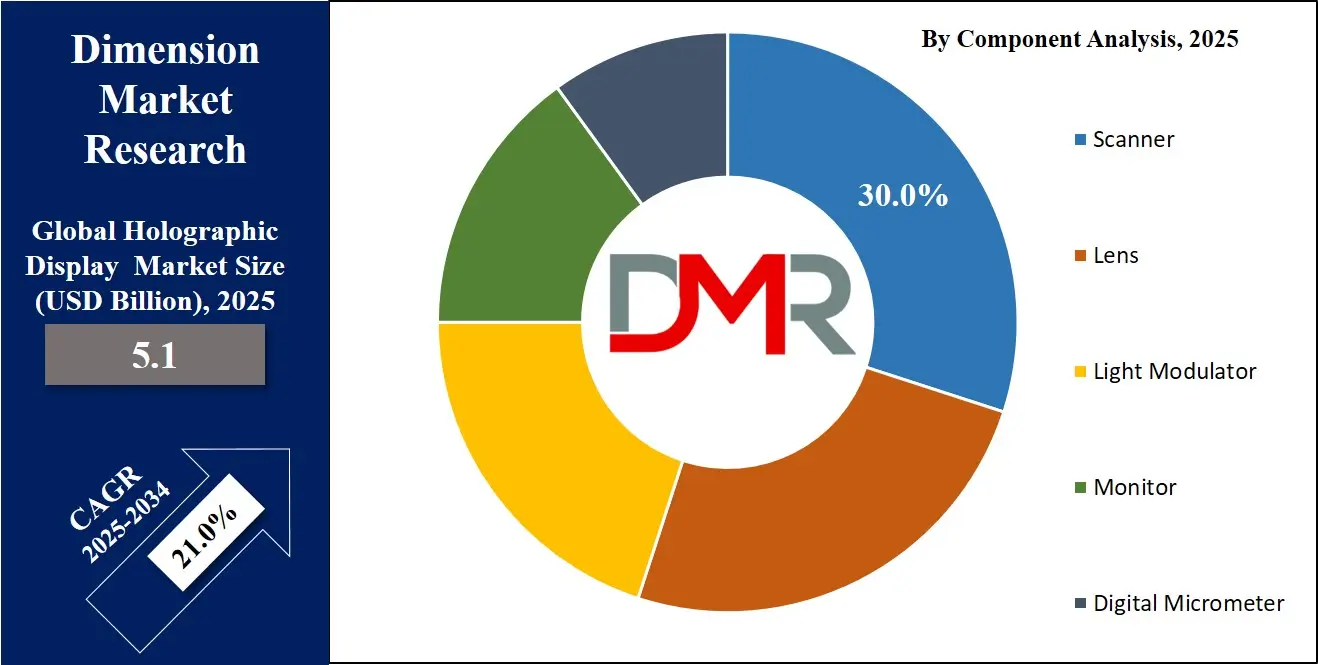
These devices are foundational in applications like augmented reality displays and real-time 3D visualizations. With rising adoption across interactive retail and automotive head-up displays, the demand for high-performance scanning components continues to surge. Manufacturers are integrating advanced beam-steering and MEMS-based scanning systems to enhance display resolution and depth perception, making the scanner segment a cornerstone of next-generation volumetric and light field holography solutions.
The digital micrometer segment is projected to grow with the highest CAGR by 2025 due to its critical function in achieving sub-micron precision in holographic imaging systems. As accuracy becomes essential in high-resolution medical holography and semiconductor lithography applications, demand for ultra-fine calibration tools rises significantly.
These devices ensure optimal alignment of optical pathways and precise measurement of micro-scale hologram layers. With the expansion of nanophotonic circuits and micro-optics in advanced 3D projection, digital micrometers are evolving to support next-gen applications. Increased R&D in photonic instrumentation and microfabrication is accelerating their adoption across diverse sectors.
By Technology Analysis
Laser technology is predicted to dominate the holographic display market by 2025, securing a share of 42.7%. The coherent and monochromatic properties of lasers enable superior image clarity and depth in holographic projection. These technologies are widely used in head-mounted displays, automotive HUDs, and AR holograms for navigation.
With the rise in demand for realistic, full-parallax imaging, laser-based systems are gaining preference for their capacity to generate dynamic and stable interference patterns. Innovations in diode-pumped solid-state lasers and tunable lasers are further enhancing holographic brightness and resolution, making them the go-to option for enterprise-grade visualization systems.
Electro holographic technology is expected to grow at the highest CAGR by 2025, supported by its ability to dynamically reconstruct 3D scenes through spatial light modulation. This approach allows real-time image manipulation without the need for mechanical movement or multiple viewing angles, which is highly suitable for AR/VR, holographic conferencing, and defense simulation.
Its compatibility with photopolymer materials and LCOS panels enables efficient, compact designs. As the need for interactive and programmable visual content increases, electro holography is becoming integral to future-ready display systems in smart environments and AI-powered interfaces.
By Dimension Analysis
3D holographic displays are anticipated to dominate the global market by the end of 2025, capturing an estimated 53.9% share. These displays offer a life-like depth perception and spatial immersion, ideal for retail marketing, product demos, and automotive visualization.
The popularity of 3D holograms is fueled by advancements in real-time rendering engines and holographic projection kits compatible with existing devices. Industries are adopting 3D visualization to reduce prototyping costs and enhance customer interaction. Furthermore, consumer electronics brands are integrating 3D holograms in wearables and display panels, which is accelerating market penetration and enhancing user experiences across sectors.
The 4D dimension segment is expected to grow with the highest CAGR by 2025, owing to its capacity to include the element of time alongside 3D spatial data. This enables dynamic holographic experiences such as interactive storytelling, real-time simulations, and time-sequenced medical visualizations.
Industries such as defense training, live holographic performances, and data analytics are exploring 4D for more complex, time-evolving representations. As volumetric video and motion capture technologies evolve, 4D holography is becoming critical for creating immersive environments in theme parks, experiential retail, and smart cities.
By Application Analysis
Digital signage is projected to be the leading application in the holographic display market by 2025, accounting for 28.4% of the market share. Businesses are increasingly using holographic signage to attract consumer attention in crowded retail spaces and exhibitions.
These systems deliver eye-catching, floating 3D visuals that enhance customer engagement and brand recall. Advancements in spatial light modulation and projection optics are making it feasible to deploy these systems in shopping malls, airports, and event venues. With the integration of AI and motion sensors, these displays are becoming more interactive and adaptive, further strengthening their appeal.
Medical imaging is predicted to register the highest CAGR by 2025, propelled by its application in pre-surgical planning, anatomical visualization, and medical training. Holographic displays help visualize complex internal organs and structures in 3D without radiation exposure or extensive processing. Surgeons and medical students can interact with realistic anatomical models, improving diagnostic accuracy and procedural outcomes.
The demand is especially high in neurology, cardiology, and orthopedics. Integration of real-time data from CT or MRI scans with holographic projection is transforming clinical visualization, and growing healthcare digitization is pushing rapid adoption in hospitals and academic institutions.
By End User Analysis
Consumer electronics are expected to dominate the holographic display market by 2025, accounting for a 36.5% share. The demand for immersive interfaces in smartphones, tablets, and wearable devices drives this growth. Major tech companies are exploring holographic UI/UX to replace traditional screens with projection-based interfaces.
As spatial computing becomes central to the smart device ecosystem, holographic displays are being incorporated into AR glasses and gesture-controlled devices. Hardware miniaturization and enhanced energy efficiency are enabling the deployment of compact holographic modules within everyday gadgets, thus solidifying the consumer electronics segment’s leadership in this domain.
The healthcare sector is set to grow with the highest CAGR by 2025 due to its increasing reliance on advanced visualization tools for diagnostics, surgery, and education. Holographic displays provide real-time, detailed, and interactive 3D models of organs, tissues, and pathologies, facilitating precision medicine.
Hospitals are deploying holography in telemedicine and collaborative surgeries across geographies. Its integration with AI and machine learning enhances clinical decision-making, while holographic conferencing is revolutionizing remote consultations. As regulatory approvals for digital health tools rise, the demand for cutting-edge, non-invasive, and real-time imaging technologies in healthcare is escalating rapidly.
The Global Holographic Display Market Report is segmented on the basis of the following:
By Component
- Scanner
- Lens
- Digital Micrometer
- Monitor
- Light Modulator
By Technology
- Laser
- Touchable
- Electro Holographic
- Piston
By Dimension
By Application
- Camera
- Digital Signage
- Medical Imaging
- Smart TV
- Laptop
- Others
By End User
- Retail
- Healthcare
- Consumer Electronics
- Industrial
- Defense
- Others
Regional Analysis
Region with the largest Share
North America is anticipated to hold the largest share of 36.5% in the global holographic display market by the end of 2025. The region’s dominance is driven by strong technological infrastructure, early adoption of advanced visualization technologies, and significant investments in augmented reality and virtual reality platforms. The presence of key players, including Microsoft, MDH Hologram, and RealView Imaging, supports the rapid commercialization of 3D and electro-holographic displays across various sectors.
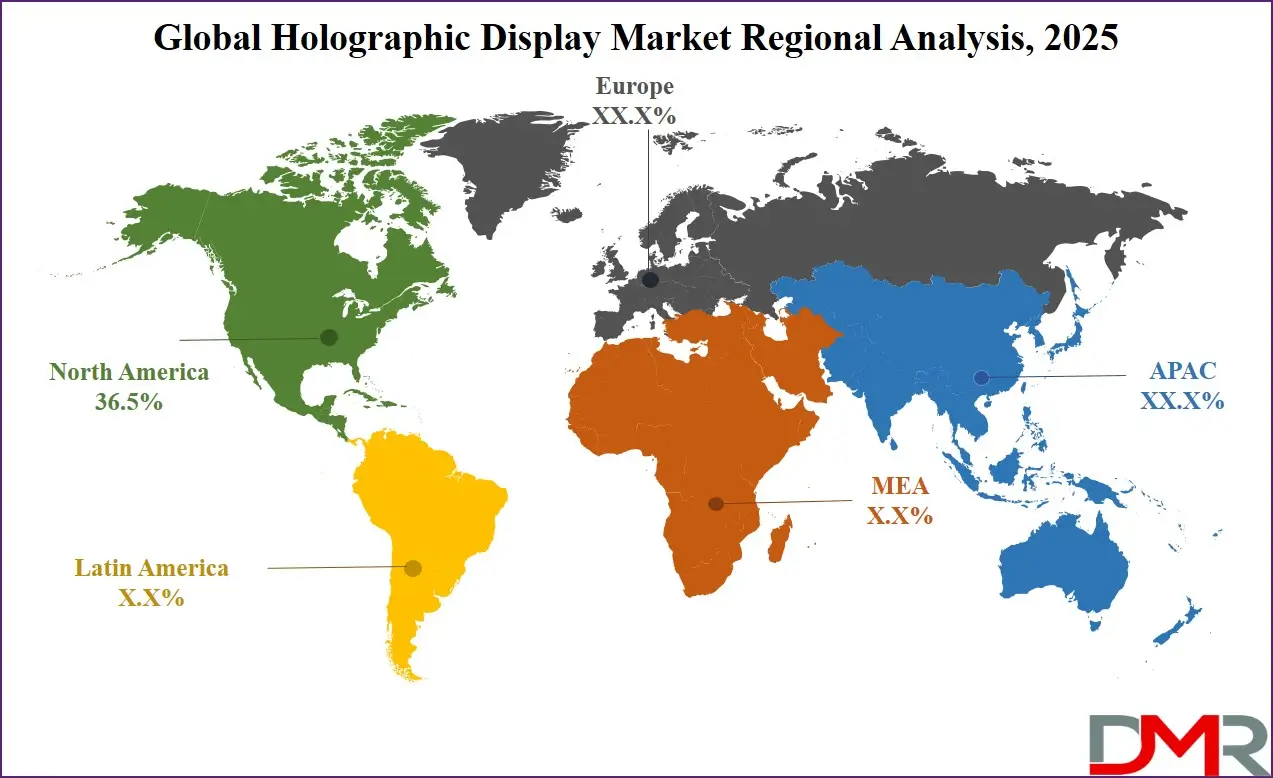
Additionally, North America leads in integrating holography into sectors such as defense simulation, medical imaging, and retail display systems. With growing demand from the entertainment, automotive, and consumer electronics industries, the region continues to be a primary hub for innovation and deployment of cutting-edge holographic display solutions.
Region with Highest CAGR
Asia Pacific is projected to witness the highest compound annual growth rate (CAGR) in the holographic display market by 2025. This rapid growth is fueled by increasing demand for advanced imaging technologies in countries like China, Japan, South Korea, and India. Government initiatives supporting smart city projects and 5G infrastructure are accelerating the adoption of immersive technologies, including holographic displays, in education, defense, and advertising.
Additionally, the rising presence of display panel manufacturers and semiconductor fabricators in the region enhances production scalability and cost efficiency. Local startups and global tech giants are also collaborating on research and development, making Asia Pacific a hotbed for innovation in volumetric and real-time holographic projection systems.
By Region
North America
Europe
- Germany
- The U.K.
- France
- Italy
- Russia
- Spain
- Benelux
- Nordic
- Rest of Europe
Asia-Pacific
- China
- Japan
- South Korea
- India
- ANZ
- ASEAN
- Rest of Asia-Pacific
Latin America
- Brazil
- Mexico
- Argentina
- Colombia
- Rest of Latin America
Middle East & Africa
- Saudi Arabia
- UAE
- South Africa
- Israel
- Egypt
- Rest of MEA
Impact of Artificial Intelligence in the Holographic Display Market
- Enhanced Image Rendering and Realism: AI significantly improves the realism of holographic displays by enabling real-time image rendering and adaptive resolution scaling. Machine learning algorithms optimize lighting, depth perception, and object tracking, creating lifelike 3D visuals. This leads to more immersive experiences across entertainment, gaming, education, and medical visualization applications.
- Real-Time Motion Tracking and Interaction: AI-powered sensors and vision systems enable precise gesture and motion tracking in holographic interfaces. These capabilities enhance interactivity, allowing users to manipulate holograms naturally. Such intuitive interaction elevates user engagement in virtual meetings, training simulations, and augmented reality environments, driving demand for advanced holographic solutions.
- Content Generation and Personalization: Generative AI creates dynamic, personalized holographic content based on user preferences, facial expressions, or contextual data. This advancement supports applications in retail, advertising, and customer service by delivering tailored 3D projections, improving engagement, and influencing purchase decisions through highly customized and emotionally resonant visuals.
- System Efficiency and Cost Reduction: AI optimizes hardware and software integration within holographic systems, reducing power consumption, latency, and overall operational costs. Predictive maintenance, automated calibration, and energy-efficient rendering contribute to making holographic displays more accessible, reliable, and scalable for both commercial and industrial deployment across global markets.
Competitive Landscape
The global holographic display market is highly competitive, with key players focusing on technological innovation, product differentiation, and strategic partnerships to gain market share. Companies like Microsoft Corporation, Looking Glass Factory, MDH Hologram, RealView Imaging, and Leia Inc. are at the forefront of developing cutting-edge solutions, including electro-holographic displays, laser-based volumetric displays, and touchable holograms. These firms are integrating advanced components such as spatial light modulators, high-resolution scanners, and light field engines to improve image depth, resolution, and interactivity.
Startups are actively entering the market with novel applications in medical imaging, digital signage, and augmented reality, while established tech giants are leveraging their R&D capabilities to embed 3D holographic displays into consumer electronics and automotive interfaces. Furthermore, collaborations between universities, research labs, and enterprises are accelerating innovation in real-time holography, interactive projection, and multimodal display systems.
Geographically, firms in Asia Pacific are strengthening their manufacturing capacities to meet the growing demand for holographic display panels, particularly in smart devices and wearables. With rising investments in immersive visualization and optical technologies, the competitive landscape is set to intensify, pushing companies to enhance performance, scalability, and user engagement through continuous technological advancements.
Some of the prominent players in the Global Holographic Display Market are:
- Looking Glass Factory
- RealView Imaging
- Leia Inc.
- Holoxica Limited
- MDH Hologram
- HYPERVSN
- Voxon Photonics
- VividQ
- Shenzhen SMX Display Technology
- SeeReal Technologies
- Light Field Lab
- Provision Interactive Technologies
- ZHENGLANG Technology
- Kino-mo
- Vision Optics GmbH
- Musion 3D
- EchoPixel
- Realfiction Holding AB
- WayRay
- Magic Leap
- Other Key Players
Recent Developments
- In January 2024, Konica Minolta entered a strategic partnership with a German optics company to co-develop ultra-thin holographic display panels measuring less than 2 mm in thickness, aiming to embed these displays into automotive dashboards.
- In October 2023, Qualcomm launched its Snapdragon HoloPro 7 chip, specifically designed for mobile holographic computing. The chip delivers a processing speed of 3.8 GHz and boasts a 25% improvement in energy efficiency compared to its previous version.
- In July 2023, Eon Reality unveiled AI-driven holographic learning modules, which led to a 22% improvement in concept comprehension for STEM subjects during pilot programs in selected schools.
- In December 2023, Realview Imaging secured FDA approval for its Holoscope-i, a cutting-edge holographic imaging system intended for visualizing heart surgeries. The system was subsequently implemented in 19 hospitals across the United States.
Frequently Asked Questions
The Global Holographic Display Market is estimated to reach USD 3.0 billion in 2023, which is further expected to reach USD 20.7 billion by 2032.
North America dominates the Global Holographic Display Market with a share of 35.2% in 2023.
Some of the major key players in the Global Holographic Display Market are AV Concepts, Holoxica, Kino-mo, and many others.
The market is growing at a CAGR of 23.9 percent over the forecasted period.